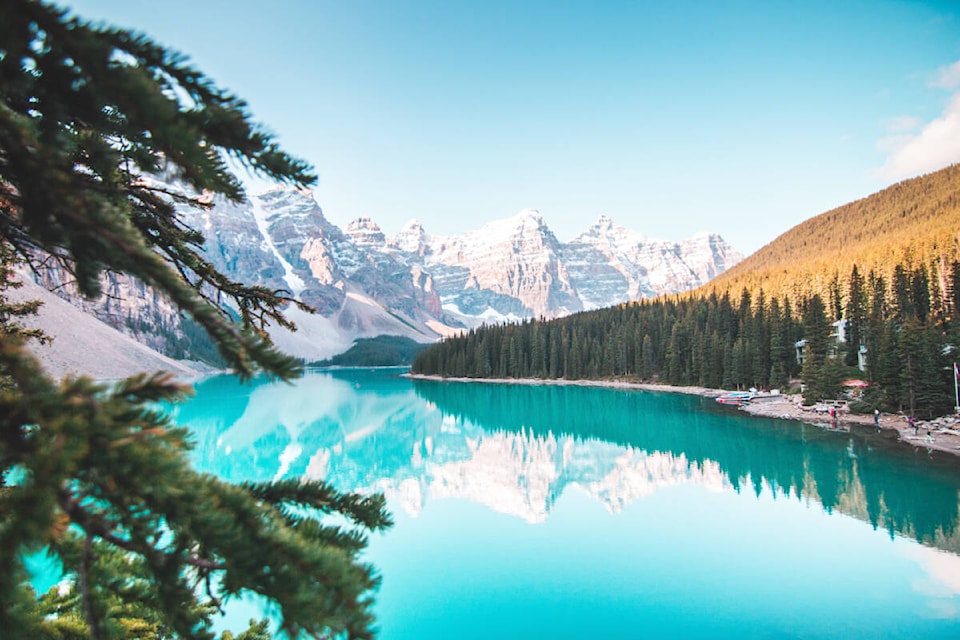A storm is brewing at picturesque Moraine Lake in Banff National Park, pitting Parks Canada — a federal institution — against the Alberta government, which is opposing a plan to ban private vehicles along the road to Moraine Lake, the most popular tourist attraction in the park. Instead, visitors wanting to see the lake will have to park at a distance and travel in via Parks Canada-operated shuttle buses, commercial buses, or taxi.
The Parks Canada plan is in attempt to alleviate the current situation, which sees up to 5,000 vehicles turned away each day because of lack of capacity in the parking lot at the site, which accommodates 900 vehicles and is at capacity 24 hours a day. Would-be visitors tell stories of getting there at 6 a.m. only to find the parking lot already full with people who arrived the night before and slept in their cars to beat the rush.
Parks Canada wants to ensure that the ecosystem around Moraine Lake is preserved and that as many people as possible are able to visit the lake without disturbing it. However, Alberta’s minister of forests, parks, and tourism, Todd Loewen, has called on Parks Canada to reverse the decision. In an official statement, he wrote “When you have a world-renowned destination like Moraine Lake in your backyard, you want to do everything you can to ensure that it can be enjoyed by everyone.”
Loewen called on the federal government to look at “other options” to solve the issue. Speaking to a local radio station, Loewen suggested an option of his own. Rather than deploy shuttle buses, he said, Parks Canada should instead build a bigger parking lot at the lake.
Just to be clear: Parks Canada isn’t merely concerned with the number of people who are being turned away from Moraine Lake, it’s worried about the environmental impact that those thousands of personal vehicles each day have on a fragile ecosystem. Loewen’s suggestion of simply paving paradise and putting up a parking lot is a nice nod to Joni Mitchell, but it’s so utterly tone-deaf, if not downright stupid, that it sounds like a Monty Python skit, or something Manuel might suggest to Basil Fawlty, whereupon Basil would summon Manuel closer and then smack him upside the head.
The idea of having people park at a distance from a popular destination and then take a shuttle is one that many sites around the world have adopted. It’s been many years since I visited the Fortress of Louisbourg in Nova Scotia, which is also operated by Parks Canada, but even in the 1970s visitors parked at an interpretive site a few miles away from the fortress and then travelled by bus to it, and no one grumbled.
Loewen’s suggestion, apparently made in all seriousness, is a reflection of the belief many people seem to have in their right to drive their vehicle when they please, wherever they please, with no restrictions. There’s also a faint whiff of disparagement of anything that smacks of “public transit”, which shuttle buses are, and rebellion against “big government” telling people what they can and can’t do.
In France, the Lascaux Caves and their 17,000-year-old paintings have been closed to the public since 1963, as the exhalations of more than a thousand visitors a day and the introduction of light to the caves brought lichens, fungi, and mold, and threatened to destroy the paintings. The French government’s solution was to build exact reproductions of the caves and their artwork near the actual site, so that visitors could appreciate them without further damaging the originals.
No one is suggesting that the federal or provincial governments build an exact reproduction of Moraine Lake anywhere, even if such a thing were possible. If we don’t want it to be loved to death, however, we need to take steps to preserve access with the least possible damage to the lake and its environment. Investing in shuttle buses, rather than cement, seems a very sensible solution.
editorial@accjournal.ca
Like us on Facebook and follow us on Twitter
